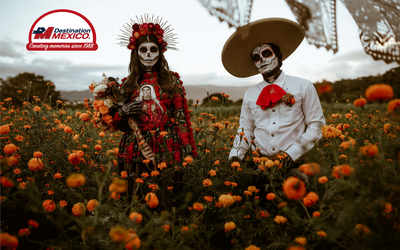
W E L C O M E
DESTINATION MEXICO
A premier Destination Management Company in Mexico since 1988
Our Offices: Mexico City, Puerto Vallarta, Cancun & Los Cabos
Email: info@destination-mexico.com

W E L C O M E
DESTINATION MEXICO
A premier Destination Management Company in Mexico since 1988
Our Offices: Mexico City, Puerto Vallarta, Cancun & Los Cabos
Email: info@destination-mexico.com
NEWS
Discover two of Mexico’s most iconic Day of the Dead traditions
The second day of November brings with it one of Mexico’s most impressive and
recognisable celebrations – Día de Muertos, or Day of the Dead, is known around the
world for its beauty, its message and, most of all, its many traditions. Join us in finding out
about two of its most striking traditions: the use of the Mexican marigold flower, known
locally as cempasúchil; and the famous skeletal figure known as “La Catrina.”
THE LEGEND OF THE CEMPASÚCHIL FLOWER
This beautiful legend recounts the love story of two young Aztecs, Xóchitl and Huitzilin, a
romance from which the cempasúchil flower, the Day of the Dead flower, was born.
This wonderful love story began when the two young Aztecs were still children. Xóchitl
and Hutzilin spent all their spare time playing and discovering their town together.
Although Xóchitl was a delicate girl, her family let her join her neighbor Huitzilin on his
adventures, and with time, their love flourished.
They particularly enjoyed hiking to the summit of a nearby mountain, where they would
offer flowers to the Sun god, Tonatiuh. The god seemed to appreciate their offering and
would smile from the sky with his warm rays. On a particularly beautiful day at the top of
the mountain, they swore that their love would last forever.
When war broke out the lovers were separated as Huitzilin headed to fight and protect
their homeland. Soon, the dreaded news of Huitzilin‘s death reached Xóchitl. Overcome
by grief, she decided to walk one last time to the top of the mountain and implore the Sun
god Tonatiuh, to bring her back together with her beloved Huitzilin. The sun, moved by
her prayers, threw a ray that gently touched the young girl’s cheek. Instantly, she
transformed into a beautiful flower of fiery colors, as intense as the sun’s rays.
Suddenly, a hummingbird appeared and lovingly touched the center of the flower with its
beak. It was Huitzilin, who had been reborn as a handsome hummingbird. The flower
gently opened its 20 petals, filling the air with a mysterious and lovely scent. Thus, the
legend tells, the two lovers would always be together, as long as cempasúchil flowers and
hummingbirds existed on earth.
This is how the cempasúchil flower came to be the Day of the Dead Flower. Cempasúchil is
the name given to Mexican marigold flowers – its name comes from the Náhuatl word
“cempohualxochitl,” meaning twenty petals or flowers. Nowadays, these beautiful flowers
can be seen adorning Day of the Dead offerings all around Mexico, and they are
sometimes used to create a path for the departed to follow from their tombs to the
offerings their families have carefully prepared for them.
LA CATRINA
No Day of the Dead offering would be complete without the many representations of
skulls and skeletons that have become synonymous with the holiday, and one of the most
famous of these is La Catrina. Originating as a form of social criticism and satire in the late
1800s, this spectral figure was first popularized by the Mexican artist José Guadalupe
Posada, but it was not until 1947 that Diego Rivera most famously captured her in his
mural "Sueño de una tarde dominical en la Alameda Central," in which he baptized her as
"La Catrina." Currently, La Catrina represents Mexican culture around the world and is one
of the most iconic images during the Day of the Dead, providing the basis for elaborate
costumes and decorations, as well as inspiration for playful limericks known as
“calaveras.”
The Puerto Vallarta beachfront boasts one of the tallest and most impressive Catrinas in
Mexico, as you can see in the following video!
VIDEO: CLICK HERE


